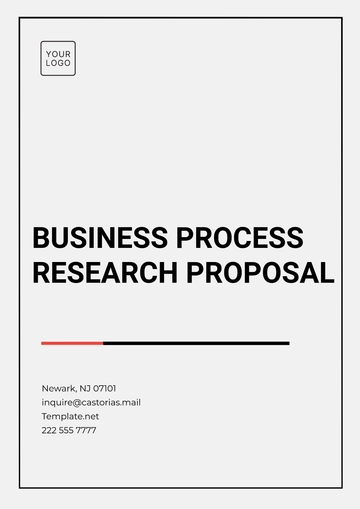Free Competitor Analysis Research Proposal

Prepared by: [Your Name]
I. Abstract
This research proposal outlines a comprehensive approach to conducting a competitor analysis. The study aims to identify key competitors, evaluate their strengths and weaknesses, and determine potential areas for competitive advantage. The findings will provide valuable insights for strategic planning and decision-making.
II. Introduction
Competitor analysis is a critical component of strategic management. By understanding the competitive landscape, businesses can better position themselves in the market, capitalize on opportunities, and mitigate threats. This research will focus on analyzing direct and indirect competitors.
III. Objectives
Identify the primary competitors.
Analyze the market share and positioning of these competitors.
Evaluate the strengths and weaknesses of each competitor.
Identify potential areas for competitive advantage.
IV. Methodology
A. Data Collection
The data collection process will involve both primary and secondary research methods.
Primary Research: Includes surveys, interviews, and focus groups with industry experts and customers to gather insights on competitors.
Secondary Research: This involves analyzing existing reports, market studies, and online databases to gather data on competitors.
B. Data Analysis
The collected data will be analyzed using SWOT analysis, Porter's Five Forces, and comparative analysis techniques.
V. Competitor Identification
Competitor | Market Share | Key Products/Services |
|---|---|---|
Competitor A | 25% | Product X, Service Y |
Competitor B | 18% | Product Z, Service W |
Competitor C | 12% | Product V, Service U |
VI. SWOT Analysis
Strengths | Weaknesses |
|---|---|
Strong brand reputation | Limited market presence |
Innovative products | High operational costs |
Opportunities | Threats |
|---|---|
Expanding into new markets | Increasing competition |
Technological advancements | Changing consumer preferences |
VII. Porter's Five Forces Analysis
Threat of New Entrants: Moderate due to high initial capital requirements.
Bargaining Power of Suppliers: Low, as there are multiple supplier options.
Bargaining Power of Customers: High, due to many available alternatives.
Threat of Substitutes: High, with many alternative products and services.
Industry Rivalry: Intense, with several strong competitors.
VIII. Conclusion
By conducting a detailed competitor analysis, companies can gain valuable insights into the competitive landscape. This information will aid in strategic planning, allowing them to capitalize on opportunities, mitigate threats, and achieve a sustainable competitive advantage.
IX. References
Porter, M. E. (1950). Competitive Strategy: Techniques for Analyzing Industries and Competitors. New York: Free Press.
Smith, J. (2051). Market analysis and competitor insights. Journal of Business Strategies, 12(3), 45–56.
Johnson, R., & Scholes, K. (2050). Exploring Corporate Strategy (8th ed.). Prentice Hall.
- 100% Customizable, free editor
- Access 1 Million+ Templates, photo’s & graphics
- Download or share as a template
- Click and replace photos, graphics, text, backgrounds
- Resize, crop, AI write & more
- Access advanced editor
Competitor Analysis Research Proposal Template, expertly crafted to streamline your market analysis process. Offered by Template.net, this template is fully customizable, allowing you to tailor every detail to your unique needs. Easily downloadable and printable, it ensures seamless integration into your workflow. Enhance your efficiency with the editable features in our AI Editor Tool, designed to simplify complex tasks and provide a professional edge.
You may also like
- Business Proposal
- Research Proposal
- Proposal Request
- Project Proposal
- Grant Proposal
- Photography Proposal
- Job Proposal
- Budget Proposal
- Marketing Proposal
- Branding Proposal
- Advertising Proposal
- Sales Proposal
- Startup Proposal
- Event Proposal
- Creative Proposal
- Restaurant Proposal
- Blank Proposal
- One Page Proposal
- Proposal Report
- IT Proposal
- Non Profit Proposal
- Training Proposal
- Construction Proposal
- School Proposal
- Cleaning Proposal
- Contract Proposal
- HR Proposal
- Travel Agency Proposal
- Small Business Proposal
- Investment Proposal
- Bid Proposal
- Retail Business Proposal
- Sponsorship Proposal
- Academic Proposal
- Partnership Proposal
- Work Proposal
- Agency Proposal
- University Proposal
- Accounting Proposal
- Real Estate Proposal
- Hotel Proposal
- Product Proposal
- Advertising Agency Proposal
- Development Proposal
- Loan Proposal
- Website Proposal
- Nursing Home Proposal
- Financial Proposal
- Salon Proposal
- Freelancer Proposal
- Funding Proposal
- Work from Home Proposal
- Company Proposal
- Consulting Proposal
- Educational Proposal
- Construction Bid Proposal
- Interior Design Proposal
- New Product Proposal
- Sports Proposal
- Corporate Proposal
- Food Proposal
- Property Proposal
- Maintenance Proposal
- Purchase Proposal
- Rental Proposal
- Recruitment Proposal
- Social Media Proposal
- Travel Proposal
- Trip Proposal
- Software Proposal
- Conference Proposal
- Graphic Design Proposal
- Law Firm Proposal
- Medical Proposal
- Music Proposal
- Pricing Proposal
- SEO Proposal
- Strategy Proposal
- Technical Proposal
- Coaching Proposal
- Ecommerce Proposal
- Fundraising Proposal
- Landscaping Proposal
- Charity Proposal
- Contractor Proposal
- Exhibition Proposal
- Art Proposal
- Mobile Proposal
- Equipment Proposal
- Student Proposal
- Engineering Proposal
- Business Proposal





























